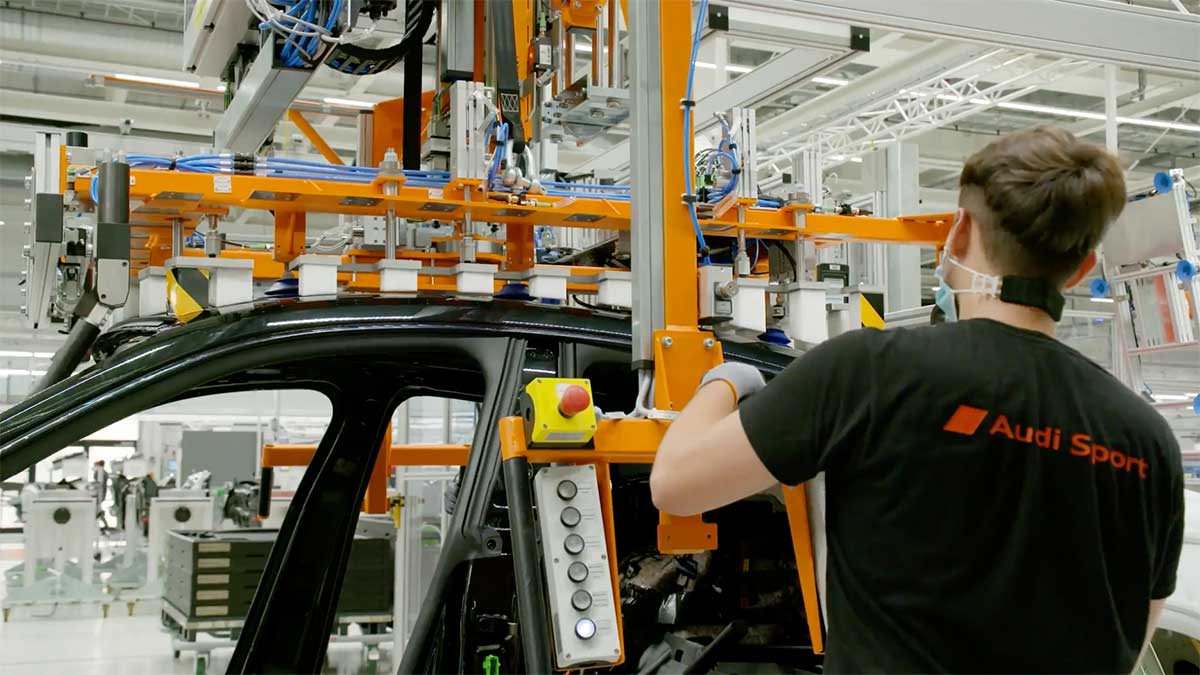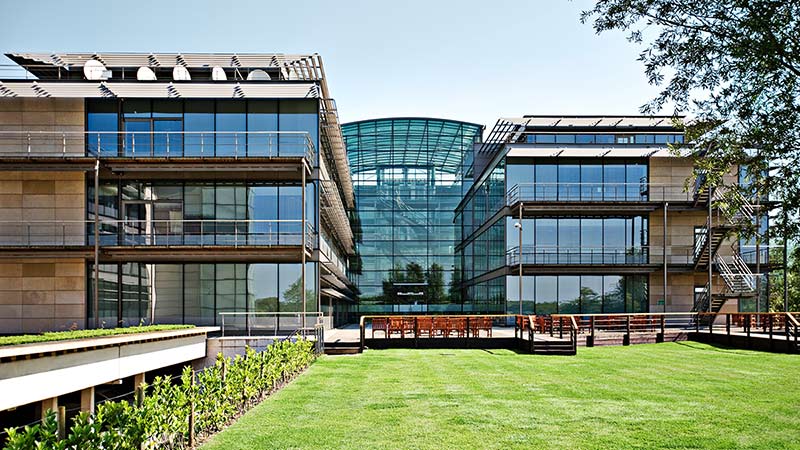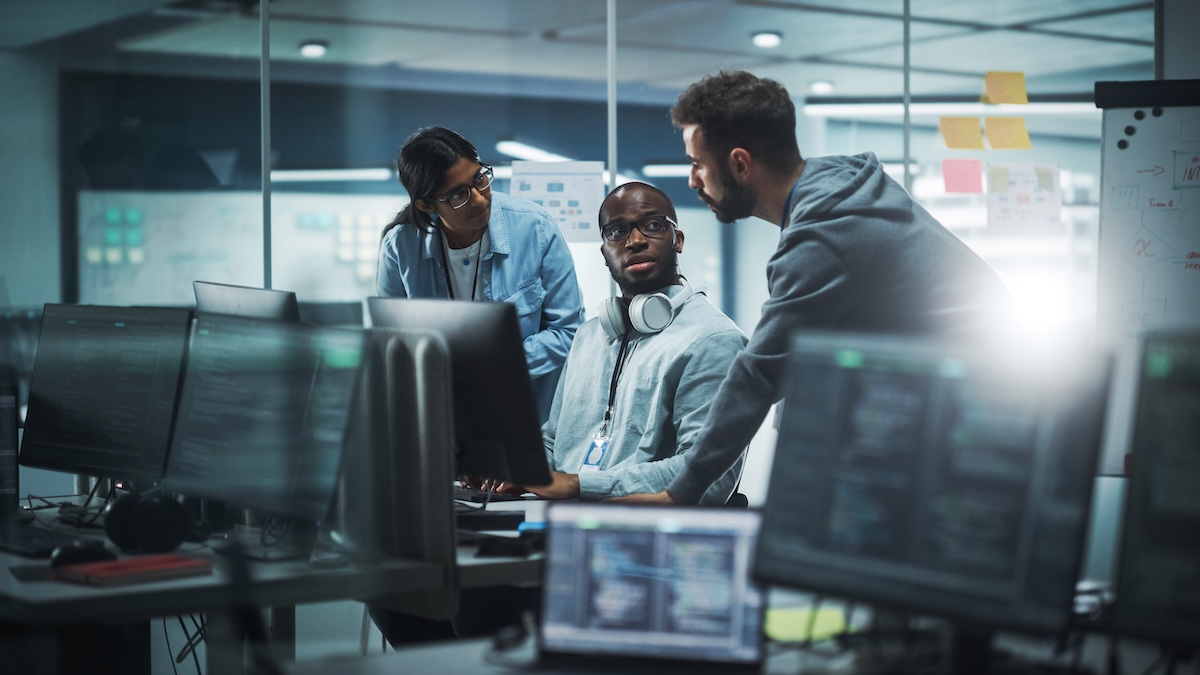Germany’s Baden-Württemberg region has a proud history of precision manufacturing dating back more than a hundred years. But for Audi, it’s all about the future.
The company’s Böllinger Höfe plant is a marvel of efficiency, sustainability, and craftsmanship. And with highly virtualized processes and AI-powered solutions, it showcases a new way forward for Audi, its parent company VW, and the auto industry as a whole.
“It’s about transforming our factories that we have around the world into smart factories,” said Dr. Henning Loeser, senior manager of the Audi Production Lab. “We call them 360factories because it's not only about installing new sensors, smart devices, and smart processes. It’s also about making these factories optimal for our employees.”
The carbon-neutral Böllinger Höfe production facility turns out high-quality but lower-volume-production vehicles like the electric Audi e-tron GT and the Audi R8 sports coup. So, it’s a perfect test bed for the innovative ideas coming from Loeser and his team. These include everything from Virtual Reality (VR) production planning to, in partnership with Cisco, hyperconverged infrastructure and ultra-low-latency networking to tie it all together, securely.
The result is a model for the future of manufacturing, as Harry Forbes, research director at ARC Advisory Group, believes.
“The whole industrial automation industry is moving in this direction,” he said. “I just think Henning and the Audi people are at the prow of the ship. I don’t see anyone near them.”
Where efficiency and security meet
The production of the Audi e-tron GT illustrates what’s possible in this new paradigm. It went from design to production in record time — without a physical prototype.
“We want to do everything in the most economical, fastest, and most efficient way possible,” said Loeser. “But how do you do it without a prototype? Our Production Lab was the nucleus of a project called Virtual Workshop, and we showed that this is doable in virtual reality. Now, it will be rolled out over the entire VW group.”
Virtual reality prototypes are just the beginning. Thousands of assets in the Böllinger Höfe plant operate under the aegis of Audi’s Edge Cloud 4 Production (EC4P), with critical networking and security support from Cisco. And by connecting “brownfield” legacy hardware — that is, existing devices like cameras, robots, Internet of Things (IoT) sensors, and field busses — the transformation did not demand a complete factory overhaul. It did, however, benefit from the efforts of Cisco’s Customer Experience team to bring the vision to life.
“Cisco is a key part of the Edge Cloud — Audi’s virtualized platform for production,” said Samuel Pasquier, VP of Cisco’s Industries Product Group (IPG). “There’s a lot of devices on the plant floor talking to one another and collecting production-process information, so Henning and his team need a solid, secure, resilient, deterministic network to make it all happen.”
This overarching virtualization greatly impacts efficiency, observability, energy usage, and maintenance, to name but a few advantages. For example, software upgrades used to involve many people working weekends going from device to device individually; now it can be done virtually in far shorter time.
Of course, a high-profile company like Audi will always be in the crosshairs of hackers. Tillman Taubert, Cisco’s IoT vertical acceleration leader for EMEA, explained some of the enhanced security built into Cisco’s network, even when connecting older, potentially vulnerable devices.
“They have implemented a lot of visionary stuff,” Taubert said. “But if you have a large field of potentially vulnerable assets, you want to make the threat surface as small as possible. With segmentation, if you have an incident you are losing maybe one asset, not a whole factory. We also bring in advanced malware protection and all the other defenses that are built into every one of our networks, not bolted on afterwards.”
Audi relied on additional partners to enable Böllinger Höfe’s transformation. But Forbes applauded Cisco’s role.
“It’s a very specialized application,” he said, “but Cisco’s dedication to the network space is all but unmatched for this kind of application.”
Forging a sustainable way forward
By utilizing renewable energy sources, circular economy principles, and energy-saving technologies, Böllinger Höfe strives to be as sustainable as any factory in the world. Cisco’s hyperconverged infrastructure solutions are a key part of this.
“When we switch to a virtualized setup, we actually save on primary energy consumption,” said Loeser. “One reason is that we can consolidate several industrial PCs on the single server. That enables much better use of energy. And that one server consists of much fewer parts and hardware, so you need less raw materials, replacement parts, and copper cable.”
Moreover, in a virtualized environment, upgrading software is a lot less impactful than replacing hardware.
“Currently in the physical world, automakers need to periodically replace much of their technology,” explained Taubert. “In a virtualized world, you can do much of that just by upgrading or installing new software. So, no scrap materials, no need for recycling, no replacement technology. The impact across the whole chain is quite significant.”
Predicting problems before they happen
Loeser’s Production Lab team has spent the past five years developing AI algorithms to control and monitor assets like spot welding machines at Audi production plants. The goal was to increase efficiency and enable advanced predictive maintenance, but without driving excessive costs, bandwidth demands, or complexity.
Again, hyperconverged infrastructure will make scaling AI algorithms more efficient.
“We knew AI could help our production,” Loeser said. “But we couldn’t allow it to create a maintenance nightmare. So we looked into how the hyperscalers do this. They don’t set up individual PCs. They do all of this in a hyperconverged infrastructure. Updates are fully automated with software-defined scripts.”
In terms of predictive maintenance, AI is enabling precise monitoring of machines, anticipating problems before they happen. That can extend the lifecycle of assets.
“With the AI algorithms, they can predict what it is going to break and when it needs maintenance,” said Paul Didier, solutions architect manager for Cisco’s Industries Product Group. “That increases the amount of time it can run, allowing them to use fewer parts and get better quality — with less waste in the production environment.”
As advanced as this sounds, Loeser believes it’s just the beginning of what’s possible.
“There are hundreds more applications that can be virtualized,” he stressed. “And we would like to show these solutions to the automation world. Software enables a production system that is fit for the future.”
The Cisco/Audi partnership will surely pave the way for that future.
“Audi and Cisco shared the vision of getting rid of the compute hardware from the shop floor and virtualizing it,” Loeser concluded. “That’s one of the big reasons why we are actually deploying this today.”





